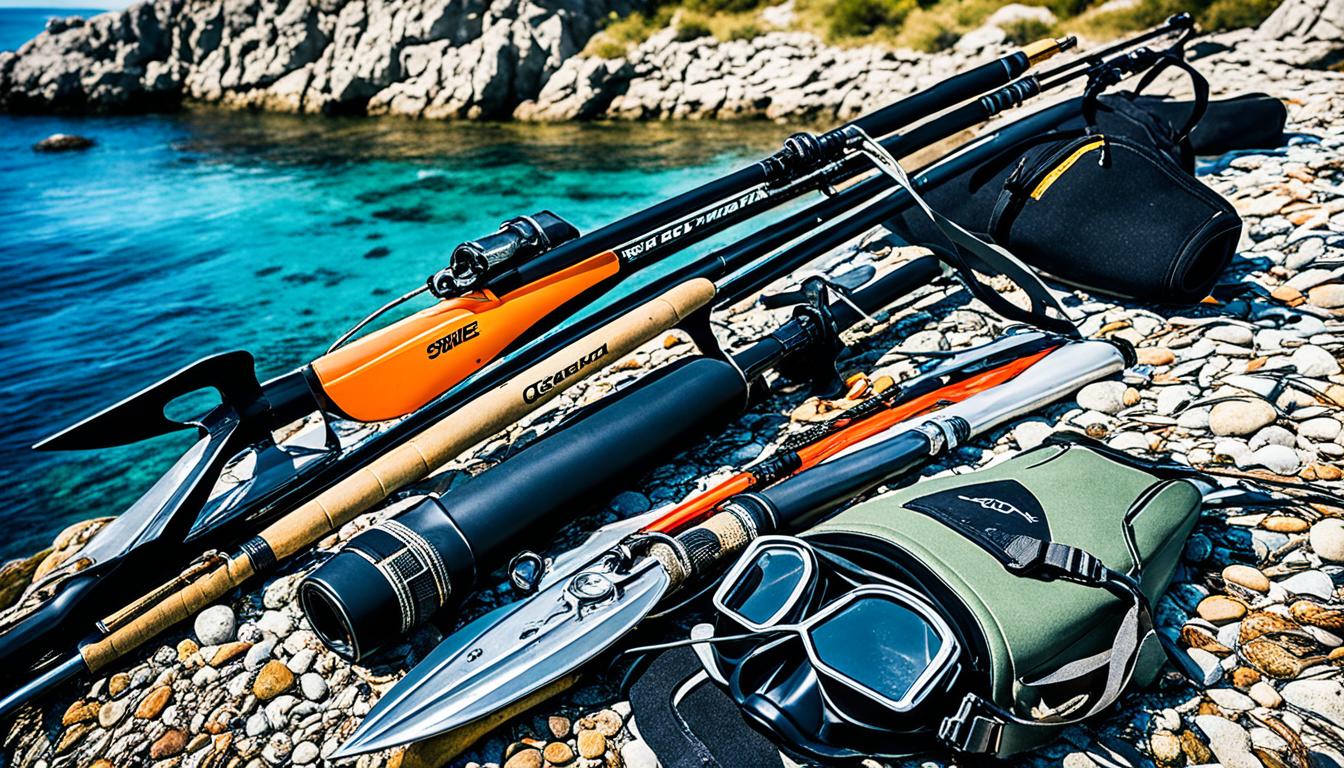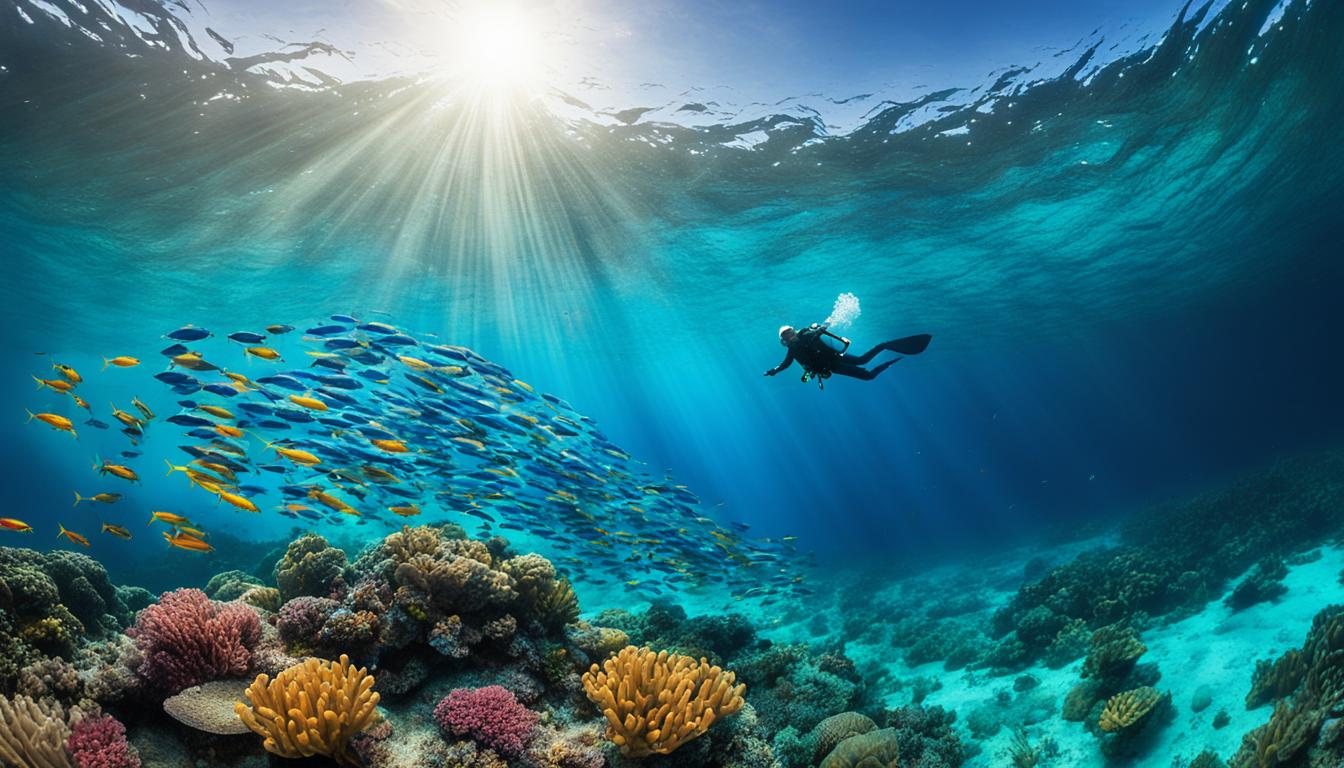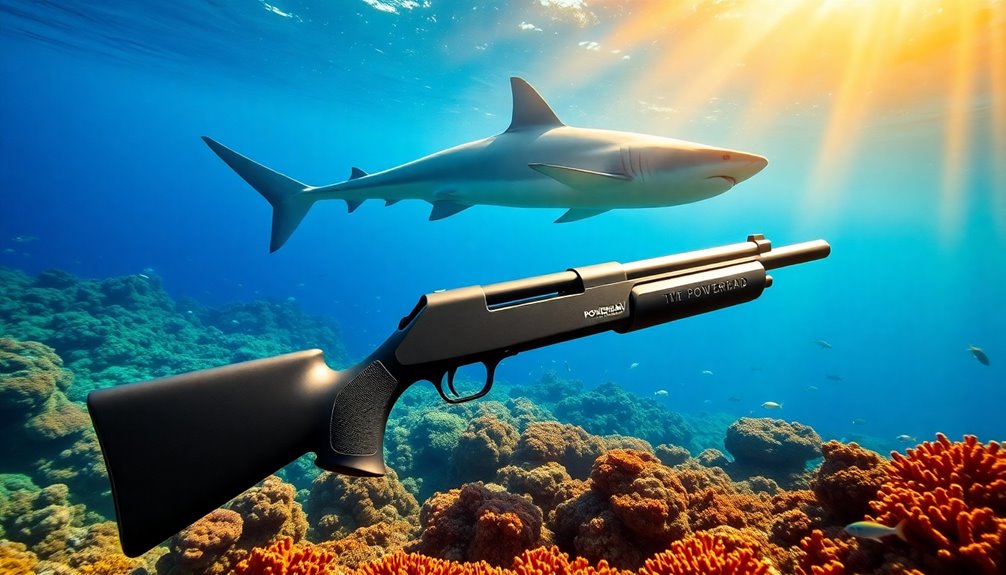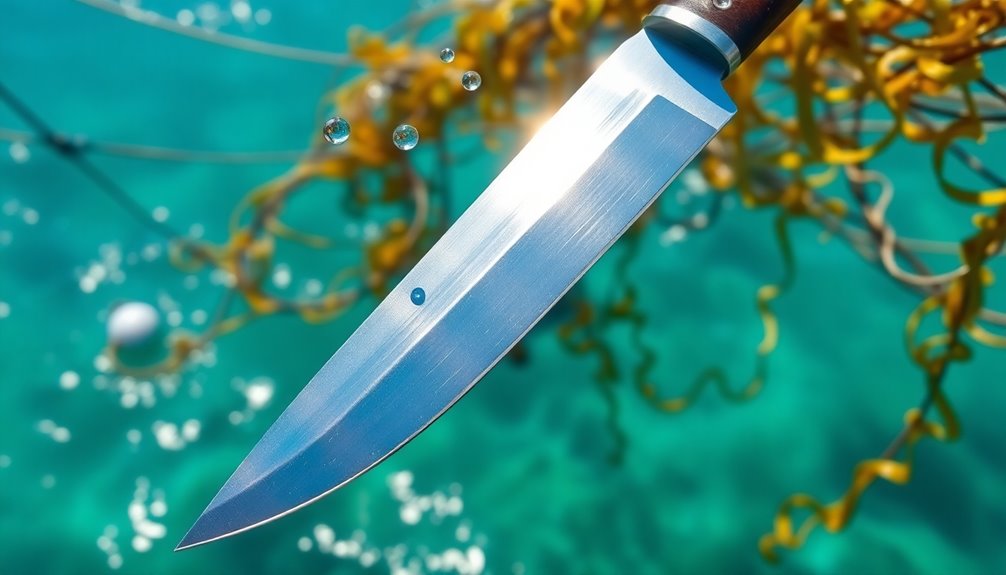Picture this: you’re floating weightlessly in the crystal-clear waters, surrounded by the vibrant marine life. You feel the thrill of anticipation as you dive deeper, spear in hand, ready to hunt underwater. Spearfishing, the ancient practice of hunting fish underwater, is not only an exhilarating sport but also a way to connect with nature. However, like any adventure, it comes with its share of risks. It’s important to understand and manage these risks to ensure your safety and the well-being of the marine environment. Before embarking on your journey, it’s crucial to practice proper techniques and familiarize yourself with local regulations to preserve the delicate balance of underwater ecosystems. For those interested, there are numerous renowned spearfishing spots in Perth that offer ample opportunities to experience this thrilling activity while respecting marine sanctuaries. Always remember, responsible spearfishing ensures both your safety and the future health of our oceans.
Key Takeaways:
- Boat traffic poses a significant risk in freedive spearfishing.
- Shallow Water Blackout (SWB) is a common danger to be aware of.
- Shark attacks are a risk to consider while spearfishing.
- Accidents with spearguns and knives are more common than perceived.
- Being lost at sea is a potential risk, especially for inexperienced boat users.
Boat Traffic: A Potential Danger in Spearfishing
When participating in spearfishing activities, it is important to be aware of the potential risks associated with boat traffic. Powerboats, sailboats, and jetskis sharing the water can pose a significant hazard to spearfishers. Therefore, it is crucial to understand the safety regulations and take precautions to ensure a safe diving experience.
Boat traffic in spearfishing locations can vary, with some areas experiencing higher levels of activity than others. Divers should exercise caution when diving near shipping channels or river mouths, as these areas often have a higher concentration of boat traffic. Staying safe around boats while spearfishing requires the implementation of specific measures to minimize the risk of accidents.
Use a Float and Flag for Visibility
To alert boaters to your presence, it is essential to use a highly visible float and flag setup. This increases your visibility in the water and helps boats identify your location. By maintaining a safe distance from oncoming water traffic, you can reduce the chances of potentially dangerous encounters.
Follow Spearfishing Safety Regulations
Adhering to spearfishing safety regulations is paramount to your well-being in high boat traffic areas. Know and understand the rules set forth by local authorities regarding spearfishing activities, including any restrictions or specific measures that must be observed. By staying informed and compliant, you can minimize the risks associated with boat traffic.
Dive with a Buddy
One of the most important safety practices in spearfishing is diving with a buddy. Having a reliable dive companion can help ensure that you are not alone in challenging situations. Your buddy can keep an eye out for approaching boats or potential hazards while you focus on your dive. Together, you can navigate through boat traffic and enhance each other’s safety.
Remember, staying safe around boats while spearfishing involves a collective effort. By following proper spearfishing safety regulations, using visibility aids such as a float and flag, and diving with a buddy, you can significantly reduce the risks associated with boat traffic and enjoy a safer spearfishing experience.
Shallow Water Blackout: Understanding and Preventing It
Shallow Water Blackout (SWB) is a serious risk that spearfishers need to be aware of and take precautions against. SWB refers to the loss of consciousness while ascending from a dive, usually within 3-6 meters (10-20 feet) of the surface. It occurs when the oxygen levels in the body drop too low, leading to unconsciousness.
One of the most common causes of SWB is hyperventilation, or over-breathing, which can occur when spearfishers attempt to flush carbon dioxide from their bodies. However, hyperventilation actually decreases the body’s ability to hold its breath and can increase the risk of SWB. It’s important to understand the dangers of hyperventilation in spearfishing and to avoid it to prevent SWB.
To prevent SWB and ensure spearfishing safety, here are some tips and precautions to keep in mind:
- Avoid hyperventilation: Instead of over-breathing, aim for relaxed and controlled breathing before a dive.
- Dive with a buddy: Having a diving partner increases safety, as they can provide assistance in case of an emergency.
- Be prepared to perform a rescue: Spearfishers should undergo proper rescue training and be prepared to assist an unconscious diver if necessary.
- Gradually increase dive times and depths: Pushing the limits too quickly can increase the risk of SWB. It is essential to train and acclimate the body gradually to longer dive times and deeper depths.
- Listen to your body: Pay attention to any signs of fatigue, discomfort, or dizziness during a dive. If something doesn’t feel right, it’s best to surface and rest.
- Take care of your health: Being well-rested, hydrated, and nourished is crucial for safe spearfishing. Avoid diving when hungry, dehydrated, or under the influence of alcohol or drugs.
- Avoid diving with a snorkel in the mouth: If a blackout occurs, having a snorkel in the mouth can hinder rescue efforts. It’s safer to remove the snorkel before diving.
- Watch your ascent: Looking up while ascending can decrease blood flow to the brain and increase the risk of a blackout. Maintain a controlled ascent and be aware of your body’s response.
By following these spearfishing safety tips and taking steps to prevent shallow water blackout, spearfishers can enjoy their sport while reducing the risks associated with SWB. It’s important to remember that even experienced spearfishers can succumb to SWB, so managing risk at all levels is crucial. Prioritizing safety and understanding the dangers of hyperventilation can make a significant difference in preventing SWB and ensuring a safe diving experience.

Sharks: Assessing the Risk and Staying Safe
When spearfishing, it’s important to be aware of the potential risks of shark attacks in order to stay safe in the water. While the presence of sharks can be intimidating, it’s crucial to remember that most sharks are not interested in humans as prey. In fact, benthic and pelagic sharks play a vital role in the ecosystem as apex predators, regulating prey populations and maintaining balance.
When diving in California, spearos may encounter various sharks, including benthic sharks like swell sharks, horn sharks, and leopard sharks, as well as pelagic sharks like sevengills, threshers, spiny dogfish, smoothhounds, and blue sharks.
In 2018, only 5 unprovoked shark attacks were recorded along the entire Pacific coast, with all of them occurring in California and none being fatal. Statistical data shows that the risk of a shark attack is relatively low compared to other water-related dangers, such as drowning incidents which average 288 annually at the beach.
To reduce the risk of shark attacks while spearfishing, here are some shark safety tips:
- Always dive with a buddy. Swimming, diving, or surfing in groups can deter potential shark attacks and provide assistance in case of emergencies.
- Avoid swimming, diving, or surfing in areas known to have dangerous shark congregations.
- Stay out of the water if sharks display aggressive behavior such as thrashing or quick, erratic movements.
- Observe cues from other animals in the environment. Pay attention to their behavior as they can help detect potential predators and understand the surroundings.
- Avoid swimming near river mouths, especially after rainstorms, as they can wash potential food items into the sea, attracting sharks.
- Avoid wearing shiny jewelry in the water, as it can reflect light resembling fish scales, potentially attracting sharks.
- Be cautious during dawn, dusk, and night, as sharks are more active during these times.
In addition to these safety tips, there are shark repellent devices available specifically designed for spearfishing. One such device is the Ocean Guardian Shark Shield, which has been supported by studies showing a decrease in white shark interactions and breaches when activated. By using these shark repellent devices, spearos can have peace of mind and an added layer of protection in the water.
Remember, when encountering a shark, staying calm is essential. Avoid splashing water or waving your arms, as these actions can attract the shark’s attention. In case of a shark attack, apply direct pressure to control bleeding, call for medical assistance, and keep the patient reassured until help arrives.
Shark Attacks Worldwide
| Year | Unprovoked Attacks | Provoked Attacks |
|---|---|---|
| 2022 | 57 | 32 |
According to statistics from 2022, there were 108 cases of shark-human interactions, with 57 being unprovoked attacks and 32 being provoked attacks. The United States witnessed the highest number of unprovoked shark attacks, with 41 incidents, followed by Australia with 9 cases. The most common shark species involved in fatal and non-fatal attacks are great white, tiger, and bull sharks.
It’s important to remember that while the risk of shark attacks exists, it should not deter spearos from enjoying their passion. By following these shark safety tips and utilizing shark repellent devices, spearfishers can minimize the risks and have a safe and enjoyable experience in the water.

Accidents with Spearguns: a Common Danger
Spearfishing can provide thrilling underwater adventures, but it comes with its share of risks. Among these risks, accidents with spearguns are a common and significant danger that spearfishers need to be aware of. Improper handling of these powerful weapons can lead to serious injuries, and it is essential to prioritize speargun safety at all times.
Reports from diving safety boards consistently highlight how mishandling spearguns has resulted in accidents and injuries among spearfishers. To prevent such incidents, treating spearguns like firearms is crucial. This means never pointing the muzzle of the speargun at anything you do not intend to shoot. Regardless of the circumstances, always remember to keep the muzzle pointed in a safe direction.
It is also essential to be aware of what is behind your target. Before taking a shot, ensure there are no other divers in the line of fire. This awareness can prevent accidental shootings and potentially save lives. Additionally, it is highly recommended to unload the speargun when not in use. This practice adds an extra layer of safety and minimizes the risk of accidental discharge.
“Spearguns can be powerful weapons, capable of causing serious injury if mishandled.”
By implementing these simple speargun safety tips, you can significantly reduce the risks of speargun accidents. Remember, prevention is always better than dealing with the consequences of an unfortunate incident. Exercise caution, be responsible, and prioritize safety when using spearguns during spearfishing adventures.
| Speargun Safety Tips |
|---|
| Always treat spearguns like firearms. |
| Avoid pointing the muzzle at anything you do not intend to shoot. |
| Be aware of what is behind your target. |
| Unload the speargun when not in use. |
Remember, accidents with spearguns can be prevented by following proper safety measures and handling guidelines. Prioritize the safety of yourself, your diving buddies, and others sharing the underwater environment. By doing so, you can enjoy the excitement of spearfishing while minimizing the risks associated with speargun accidents.

Knife Wound and Major Trauma Risks in Spearfishing
When participating in spearfishing, it’s crucial to be aware of the risks associated with knife wounds and major trauma. The sport involves handling sharp objects in an underwater environment, making safety precautions paramount to preventing injuries.
One of the key factors that increase the risk of knife wounds is dealing with struggling fish. It’s important to subdue the fish before attempting to stab them, reducing the likelihood of accidents. Additionally, moving boats and awkward gloves can contribute to accidents, emphasizing the need for caution.
To minimize the potential dangers, divers should follow these speargun safety tips:
- Take care when removing and holstering your dive knife, ensuring it is secure to prevent accidental injuries.
- Subdue fish effectively before attempting to stab them, reducing the risk of unpredictable movements.
- Stay up to date with first aid training and carry a trauma kit to handle potential injuries promptly and effectively.
It’s important to understand that knife wounds and major trauma are risks that can be mitigated with proper training and adherence to safety protocols. By following these guidelines and practicing responsible spearfishing techniques, divers can enjoy the sport while minimizing the chances of accidents.
Preventing Knife Injuries: First Aid and Safety Gear
In the event of a knife wound or major trauma, it’s crucial to have the necessary first aid skills and equipment readily available. Properly equipped spearfishermen can effectively handle potential entanglements and sharp marine life.
Safety equipment such as sharp knives, sea snips, and tough gloves are essential for handling potential entanglements and protecting against sharp marine life. Additionally, electronic safety gear like VHF Radios and EPIRBs provide an extra layer of security for boats, kayaks, or floats.
Frontline Freediving offers trauma kits specifically designed for spearfishing incidents, ensuring that divers are prepared for emergencies. The episode covers a range of emergency response techniques for various injuries and accidents, including shark bites, boat prop damage, burns, broken bones, puncture wounds, and stab wounds.
Remember that prevention is key when it comes to knife wounds and major trauma. Stay vigilant, practice safe handling of knives and spearguns, and always be prepared with the necessary safety gear and first aid supplies.

| Key Risks | Preventive Measures |
|---|---|
| Handling struggling fish | Subdue fish before attempting to stab them Secure knife when not in use |
| Moving boats | Exercise caution and maintain awareness of your surroundings |
| Awkward gloves | Choose gloves that provide dexterity and ensure a secure grip |
Staying Safe and Avoiding Getting Lost at Sea
When it comes to spearfishing, the risks of getting lost at sea should not be underestimated. Inexperienced divers and those unfamiliar with the area are particularly susceptible to this danger. However, by following some essential guidelines and practices, you can significantly reduce the chances of separation from your vessel and ensure a safe diving experience.
One of the key factors in preventing separation from the vessel is practicing good buddy diving protocols. Solo spearfishing is often highlighted as a contributing factor in severe accidents, emphasizing the importance of having a dive buddy for safety. By diving with a partner, you can watch out for each other, maintain constant communication, and quickly address any potential issues that may arise during the dive.
Additionally, using dive floats and flags is crucial for visibility and indicating your presence to other boats. This is especially important in high-traffic areas where collisions can occur. By prominently displaying a buoy and flag, you enhance your visibility on the water, minimizing the risk of accidents due to other boats being unaware of your presence.
Furthermore, it is vital to educate boat operators on the protocols and safety measures associated with spearfishing. Many accidents occur as a result of inattentive or untrained boat operators. Proper training in boat handling skills, understanding currents, safety procedures, navigation, anchoring techniques, and diver safety protocols is critical for ensuring a safe and enjoyable diving experience for everyone involved.
During spearfishing outings, it is important to be aware of the weather and ocean conditions. Diving in unsafe weather or rough seas significantly increases the risks of accidents and getting lost at sea. Always check the forecast before heading out and be prepared to adjust your plans if necessary to ensure optimal conditions for diving.
Lastly, it is essential to learn from the experiences of others. Approximately six individuals have been personally known to the author who have been lost at sea while spearfishing. Their stories highlight the various factors that contribute to getting lost, such as divers without visible floats, multiple divers heading in different directions, inattentive boat operators, poor topside conditions, and boat malfunctions.
By implementing these safety measures and avoiding unnecessary risks, you can enjoy your spearfishing adventures with peace of mind, knowing that you are taking the necessary precautions to stay safe and avoid getting lost at sea.

Understanding Equipment and Procedures in Spearfishing
To safely engage in spearfishing, it is important to have a good understanding of the equipment and procedures involved. Let’s take a look at some of the essential aspects of spearfishing equipment and the techniques used in this thrilling underwater activity.
Spearfishing Equipment
When it comes to spearfishing equipment, there are a few key items that every spearfisher needs:
- A speargun: Used to propel the shaft towards the target fish. Spearguns can be categorized into two types: band guns and pneumatic guns. Band guns use rubber bands as the propelling mechanism, while pneumatic guns use compressed air.
- A mask and snorkel: Necessary for clear vision and efficient breathing on the surface.
- Fins: Aid in propulsion and maneuverability in the water.
- A wetsuit: Provides insulation and protection from the elements.
- A weight belt: Helps divers achieve neutral buoyancy.
- A knife: Used for self-defense, freeing entangled lines, and dispatching fish.
- A fish carrier: Used to hold and transport caught fish safely.
- A diving watch: Keeps track of dive duration and depth.
Additionally, it is recommended to carry spare equipment such as a spare speargun and extra dive gear in case of emergencies or malfunctions.
Procedures and Techniques
In spearfishing, following proper procedures and techniques is crucial for safety and success. Here are some important guidelines to keep in mind:
- Practice neutral buoyancy techniques to conserve energy and maintain control in the water.
- Ensure you have excellent swimming and diving skills, as well as knowledge of safety procedures like unconscious diver rescue.
- Never point the muzzle or spear tip at anything unintended to be shot, as safety should always be a top priority.
- Accurately identify fish species before taking a shot, as some species may be protected by law.
- Be cautious when encountering sharks, as they can be attracted to speared fish and may exhibit unpredictable behavior.
- After catching a fish, remove it from the water as soon as possible to prevent attracting other marine creatures and minimize suffering.
Remember, it is essential to stay informed about the specific laws and regulations regarding spearfishing in your area, as they can vary significantly. Understanding and adhering to these laws will ensure a safe and responsible spearfishing experience.

By familiarizing yourself with the equipment and procedures of spearfishing, you can enhance your skills and improve your chances of a successful and enjoyable dive. So, dive in, explore the fascinating underwater world, and embrace the thrill of spearfishing!
Diving for Harvest: Risks and Safety Precautions
In spearfishing, divers face various risks, whether they choose to dive using scuba equipment or rely on freediving techniques. It is essential for spearfishers to understand and address these risks by taking appropriate safety precautions. This section explores the risks associated with scuba and freediving in spearfishing and provides valuable safety tips to ensure a safe and fulfilling diving experience.
Risks of Scuba and Freediving in Spearfishing
- Risks of Scuba Diving: While scuba diving offers longer dive times, it poses unique risks. Spearfishers must carefully manage their dive profiles, watch for potential decompression sickness, and maintain neutral buoyancy to prevent accidents. Ignoring safety measures or diving beyond one’s skill level can lead to dangerous situations.
- Risks of Freediving: Freediving allows for stealthy stalking of fish but comes with its own set of risks, particularly shallow water blackout. This dangerous condition occurs when a diver loses consciousness due to oxygen deprivation. Spearfishers must be cautious and practice proper breathing techniques to avoid shallow water blackout.
Safety Precautions for Spearfishing
To ensure a safe diving experience, spearfishers should adhere to the following safety precautions:
- Diving with a Buddy: Buddy diving is crucial in spearfishing. Having a dive buddy enhances safety by providing assistance and support in case of emergencies. Together, divers can also monitor each other’s actions and ensure compliance with local dive regulations.
- Proper Training: Beginners should enroll in certified spearfishing courses to learn safety protocols and gain a deeper understanding of marine species. Proper training helps prevent mistakes and promotes responsible spearfishing practices.
- Choosing the Right Equipment: Selecting appropriate equipment is vital for safety. This includes spear guns, wetsuits, fins, masks, and snorkels. Novice spearfishers should invest time in researching and seeking guidance to ensure they have the right equipment for their skill level and diving conditions.
- Observing Weather Conditions: Before embarking on a spearfishing trip, it is essential to check weather conditions. Dangerous diving conditions, such as strong currents or rough waves, can jeopardize safety. Planning dives during favorable weather windows is crucial.
- Clear Communication: Underwater communication through clear hand signals is essential for spearfishing safety. Establishing and understanding common hand signals helps prevent misunderstandings and ensures effective communication between dive buddies.
Impact of Spearfishing on Marine Ecosystems
| Impact | Findings/Statistics |
|---|---|
| Reduction in Coral Trout Density | 54% reduction in density at Palm Island after allowing spearfishing in a multi-use conservation area |
| Reduction in Mean Size of Coral Trout | Intensity of spearfishing activities reduced the mean size of coral trout by 27% at Palm Island between 2004 and 2009 |
| Elimination of Depth Refugia | SCUBA spearfishing has eliminated depth refugia of various reef fish species in Guam and CNMI |
| Importance of Selectivity | Perceived low selectivity in spearfishing, with spearfishers often targeting anything they see |
| Illegal SCUBA Fishing Techniques | Decreased sizes of many target reef fish reported in CNMI and Guam compared to Yap indicate potential illegal SCUBA fishing techniques |
| Impact of Technological Improvements | Technological advancements facilitating nighttime SCUBA spearfishing have led to the reappearance of larger fish species in catches |
| Conservation Recommendations | Recommendation to abolish destructive fishing practices, including SCUBA spearfishing, in Micronesia to protect critical habitats |
| Depth Refuge Effect | Artisanal fishing techniques limited to depths greater than 15m, leading to a depth refuge effect |

Spearfishers play a vital role in marine conservation by practicing selective harvesting, respecting size and species regulations, and avoiding targeting protected or endangered species. By being mindful of their impact on coral reefs and marine life, spearfishers can help minimize ecological damage and contribute to the long-term sustainability of our oceans.
Conclusion
Overall, spearfishing can be an exciting and fulfilling activity for those who enjoy underwater exploration and the thrill of the hunt. While there are inherent risks involved, by following proper safety precautions, divers can ensure their own well-being and minimize potential dangers.
Staying safe underwater while spearfishing starts with understanding the risks and taking the necessary precautions. Diving with a buddy is highly recommended, as it provides an extra layer of safety and support. Additionally, being aware of your surroundings and knowing how to identify and avoid dangerous situations can significantly reduce the chances of accidents.
Properly handling and maintaining equipment is crucial for spearfishing safety. By familiarizing yourself with your gear and practicing responsible handling, you can prevent accidents and ensure that your equipment functions properly throughout your dive.
One valuable tool that can enhance safety and visibility in spearfishing is a float. Floats not only serve as a marker for your location underwater but also provide a barrier between you and potential shark attackers. They can also prevent the loss of gear and make it easier to retrieve a spear gun if accidentally released. Incorporating a float into your spearfishing kit can improve your skills and safety, regardless of your experience level. Remember, spearfishing can be a dangerous activity, so always prioritize safety and enjoy the underwater world responsibly.










